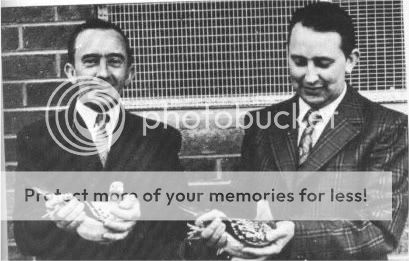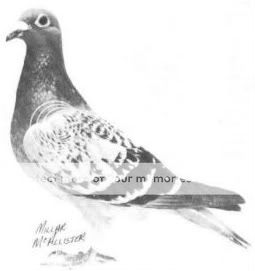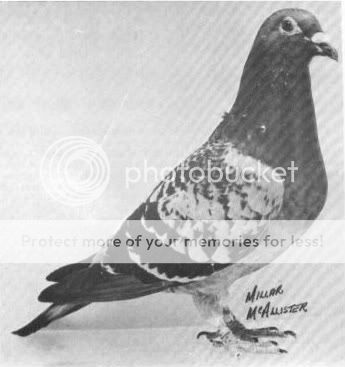By Adie McCormick
http://www.pigeonnetwork.com
METHOD, BIRDS AND LOFT
By J McDowell – 1st INFC Kings Cup Nantes 1973
One of the greatest honours a fancier can receive is being asked to contribute an article for “Squills” Year Book. We consider ourselves very privileged to receive such an invitation. Writing is not our strong point but we will do our best to describe the method, birds and loft.
The birds are fed on a mixture of beans, peas, maize, tares and are hopper fed twice daily in the racing season and once in the close season when we use less beans. A little mixed seed is given twice weekly as a tit bit; water is changed three times daily during the racing season and once in the close season. A few drops of iodine are added to the drinking water twice weekly. Fresh grit and minerals are given daily; green food is never given to the birds.

William & Andrew McDowell of Newtownards with the two winning birds in the 1973 INFC Kings Cup finishing 1st and 27th Open winning the Kings Cup and Harkness Rose Bowl for the Best 2 Bird Ave.
Our loft is cleaned out daily during the racing season and twice weekly in the winter. The floor is cleaned and then lime flour is spread over and brushed in with a good layer of sand over the floor. The lime helps to keep it dry and fresh. The inside of the loft is painted with white gloss which we wash regularly.

Blue Cheq Hen – winner of 27th Open INFC Nantes Kings Cup with loft mate 1st Open winning the Harkness Rose Bowl for the McDowell loft of Newtownards.
We do not separate the sexes till they have completed the moult, usually the end of January, as we find the birds are more content and have a better moult. Stock birds are first mated at the end of February and the racers mated Mid-March, this is done a week-ends. The birds race on the Natural system. We have no fads, breed from the best and let the basket sort them out.
During the rearing of the young extra feeding is in gallipots in the nest boxes. The Y/Birds are not separated from the O/Birds and are raced this way, and we have had good success in the Open races. Twice during the year the loft is sprayed with insecticide for mite etc. We start training at the end of March which is a few weeks before the first race and this is done privately, they get two mid-week tosses from 25 miles between the races.
Birds selected for the long distance races usually have three or four races up to Haverfordwest, 193 miles, and then trained twice weekly up to a few days before basketing for the National. We find that the birds going to the race points by air can do with less weight on them. This is different from when they were a week travelling by sea. We like them a bit on the heavy side.
The loft is opened at 6.30 in the morning. The birds have their liberty for about an hour and are then fed in. Hens are never removed from their nests and are not out until we arrive home from work at 5pm when the loft is open again for two hours.
We depend on the training tosses to keep them fit; forced exercise has never been used for fitness. We live on a private housing estate and the birds have to be kept strictly under control not to annoy the neighbours. We spend all our spare time with the birds and have them very tame. Fanciers visiting the loft often remark on how happy and content they are, we think this helps to encourage them to make a greater effort to reach home.
We select a few Y/Birds for the National which is Penzance, 309 miles, the same with the O/Birds from Nantes 543 miles, these are selected the previous year, sometimes we lose a candidate but are always left with a few fancied ones, these get special attention.
The foundation of our present family is based on the late J Leatham (Moore Gits Soffle) also later introductions from J Kenyon (Kenyon Delbar) direct. Others have been added at different times from well known long distance fanciers who are to the fore in National racing. Our aim has been to achieve success in the long distance races and we have had our share of success over the last twenty years.
Our loft was founded in the early twenties by our late father who raced successfully up to the outbreak of World War II. During the war years 10 pairs were kept, but not raced, and the youngsters from these started us racing again in 1947.
Our 1953 Kings Cup winner, Dark Cheq W/F Hen NU 49 P 5934 won Redon, 504 miles on a velocity of 790ypm. Most of our winners to the present day all carry the breeding of 5934. A Black Hen 9102 which won 4th Les Sables, 585 miles in 1960 was a G/Daughter; her sister won 2nd Co.Down Fed Derby from Skibbereen, 257 miles in 1959. She bred a Red Cheq Hen to win 40th Les Sables 1962. Black W/F Hen 9445 was timed from Les Sables in 1963 winning 51st Open and timed from Nantes in 1964, just out of the prize list. A daughter of 9102, Blue Hen, won 63rd Open Nantes 1966 and a mealy hen 57th Open Rennes 1956, both G/Daughters of 5934.
We also won the Ulster Fed from Bude and Enniscorthy with a G/Son and G/Daughter, and 11th Open Y/Bird National 1971 with a G/Daughter all from 5934. We were 17th Open Redon 1957. These are some of the positions that come to mind. Other fanciers have been successful with our birds in the Derby and National. Our 1973 Kings Cup Winner Mourneview Queen is a G/Daughter of the 1953 winner 5934. She raced very consistently always in the first few to the loft, no matter how hard or long the race was. She never showed any sign of distress as a youngster when raced up to Skibbereen 257 miles. As a yearling in 1970 she flew 5 races to Dinard 443 miles, timed 2nd day. 1971 she was 2nd Club Taunton, timed from Nantes 543 miles; 1972 flew Okehampton where her mate was lost but she mated again and was sent to Nantes sitting four days, having cast two flights.

“Mountainview Queen” Winner of 1st Open INFC Nantes 1973 Bred and Raced by A McDowell & Son of Newtownards.
She was timed at 6.28pm on the second day, winning 2nd Club, 77th Open on a velocity of 518ypm. 1973 flew Wexford 160 miles, Dungarvan 191 miles, Haverfordwest 193 miles. Trained twice weekly from 25 miles, weather permitting, and then sent to Nantes carrying one new flight, second one about one inch long and eight old flights. When sent to the National she was sitting 10 days. We had done everything that possibly could be done; it was now up to the birds to do their part.
Liberation time was 6.15 on the morning of July 7th, after a one-day holdover, the wind here was NW, very strong. We did not expect any birds would be timed on the day although we never made any inquires to find out that night. On the look-out from early morning we were standing at the side of the loft discussing the race, and wondering was it worthwhile getting up early morning; looking in a southerly direction we suddenly spotted a pigeon about a hundred yards from the loft and coming directly for it, we didn’t get time to move out of the way, it made no difference as she pitched right onto the landing board.
I opened up to let her in, but she lost a little time before coming in. I normally wear over-alls when working with them but that morning I was not wearing them.
She took to the nest again and was none the worse for her ordeal, although she lost a lot of weight. She was timed in at 6.49am. We thought she would take a good position and I learned about 10 o’clock that morning when my brother cam back from the clock centre that it was the best time. It was in the afternoon that the Secretary of the INFC came and verified the pigeon and confirmed it was the winner.
There was no one more surprised than ourselves when we learned what we thought was impossible had been achieved in winning the Kings Cup for the second time. It was a very hard race, the winning Velocity 835ypm. We had every confidence in her that she would give us her best, being in the pink of condition and pooled to £2 and Nom.
“Mourneview Queens” first pair of eggs where infertile, but she reared one youngster from the second nest having laid her fourth pair going to the National. Our second bird was timed from Nantes at 10.49am and placed 27th Open; she was a G/Daughter of 9102 and bred by our friends W & J McMaster of Ballyhalbert. We bred the dam. She preformed well in Club racing winning 2nd Arklow, 2nd Wexford, 2nd both Haverford’s and 3rd Dinard in 1972. Both birds won for us the best 2 Bird Average and the Harkness Rose Bowl, which is quite an honour in itself. These are some of our successes in pigeon racing over the last twenty years, but during that period we have had our disappointments too.
We will describe the loft which is situated in the middle of the garden, there is a concrete path running from the house to the loft. Its structure is made of rustic brick and lined inside with hard board. It measures 20ft x 8ft, divided into 3 compartments; the largest one houses the race team, the other two are used for the stock birds. Windows are fitted on both ends of the loft and the front is mainly made of half-inch square mesh wire. The roof has overhang all round, also large landing boards which helps to keep the loft dry, and is well ventilated.
The perches are made in sets of 12 with 2 & ½ inch space made to allow the scraper to pass through for east cleaning, the bottom half of the divisions are made of netting wire which allows the air to pass through and keep it fresh.